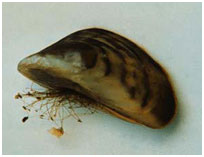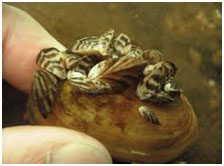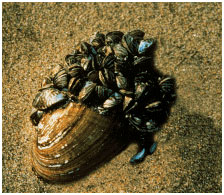Zebra Mussels
| Don't Move A Mussel | ||
The zebra mussel gets its name from the dark and light stripes on its shell that resembles those on a zebra. DESCRIPTION: Zebra mussels have a triangular shaped shell that rarely exceeds 1.5 inches in length. Their shell is bivalve meaning it has two halves. Usually the shell will have alternating dark and light bands resembling the stripes of a zebra, hence their name. However, not all zebra mussels will have this characteristic coloring pattern, some may be entirely dark or light. The most distinguishing characteristic to look for would be the tuft of fibers called the byssal threads that grow from the foot and through the hinge of the mussel. These threads allow the mussel to attach to any hard surface. A similar species that may be confused with the zebra mussel is the quagga mussel, another exotic species. DESCRIPTION: Zebra mussels have a triangular shaped shell that rarely exceeds 1.5 inches in length. Their shell is bivalve meaning it has two halves. Usually the shell will have alternating dark and light bands resembling the stripes of a zebra, hence their name. However, not all zebra mussels will have this characteristic coloring pattern, some may be entirely dark or light. The most distinguishing characteristic to look for would be the tuft of fibers called the byssal threads that grow from the foot and through the hinge of the mussel. These threads allow the mussel to attach to any hard surface. A similar species that may be confused with the zebra mussel is the quagga mussel, another exotic species.RISKS/IMPACTS: Ecologically, the zebra mussels cause many problems. One sucha problem is that they need to attach to a hard surface to survive, and these hard surfaces could be anything from many manmade objects to other animals. Zebra mussels will attach to crayfish, turtle shells as well as other mussels. When a native mussel has zebra mussels attached, the native mussel loses its ability to move, feed, breath, and breed. Eventually this will lead to the death of the native mussel. In Lake St. Clair and Lake Erie, the native mussel populations have been severely reduced due to the dense populations of zebra mussels. This dramatic drop happened only two years after the zebra mussel was discovered in the Great Lakes. This sends up a red flag for Indiana managers. With many of Indiana’s native mussels already on state or federal endangered and threatened species list, zebra mussels could spell eventual extinction.  Zebra mussels have the ability to filter up to 1 liter of water per day. They eat the phytoplankton that is suspended in the water, which is in competition with the nearly microscopic animals called zooplankton. The food chain is very delicate and the zebra mussels could be disrupting it by taking out the very bottom link, the phytoplankton. This affects all the higher organisms including the fishes. Zebra mussels have the ability to filter up to 1 liter of water per day. They eat the phytoplankton that is suspended in the water, which is in competition with the nearly microscopic animals called zooplankton. The food chain is very delicate and the zebra mussels could be disrupting it by taking out the very bottom link, the phytoplankton. This affects all the higher organisms including the fishes.Because zebra mussels filter large amounts of water, infested lakes have become clearer. While this may sound like a good thing, this can cause problems as well. With clearer water, sunlight penetrates to deeper water; this allows for more vegetative growth. This vegetation can become so thick that it could hinder swimming and boating. While zebra mussels feed on phytoplankton, they do not eat blue-green algae. Because the blue-green algae are not being eaten, there is a competitive advantage over other algae resulting in a blue-green algae bloom. Such blooms occur in Lake Huron and Lake Erie much more frequently than ever before. Some forms of blue-green algae produce toxins. If enough blue-green algae toxin is produced, harm can occur to fish, waterfowl and any other animals that drink the water, including humans.  Yet another ecological impact that the zebra mussels impose on our native fauna is the fact that they are bioaccumulators. Any contaminant in the water is multiplied up to 10 times the water concentration in the zebra mussels. When the mussels are eaten, the contaminant concentration increases through the food chain. As zebra mussels become more prevalent more animals will eat them increasing the chance that higher levels of toxins will be accumulated throughout the food chain. Yet another ecological impact that the zebra mussels impose on our native fauna is the fact that they are bioaccumulators. Any contaminant in the water is multiplied up to 10 times the water concentration in the zebra mussels. When the mussels are eaten, the contaminant concentration increases through the food chain. As zebra mussels become more prevalent more animals will eat them increasing the chance that higher levels of toxins will be accumulated throughout the food chain. The zebra mussel is also economically detrimental. The mussel’s need to attach to hard surfaces creates problems. Water intake structures are prime locations for attachment. These intakes provide a continuous flow of water and protection from predators. Once inside a pipe the zebra mussels layer on top of each other eventually causing reductions in pumping capabilities and even complete blockages. Industrial water pipes are not the only ones at risk. Residents whose cottages rely on lake water could see clogging of their supply lines. These pesky mussels get into engine cooling systems on boats, increase the deterioration of piers, increase the corrosion of steel and concrete, they have even sunk navigational buoys because the buoy could not support the additional weight. Beaches can become covered in the sharp zebra mussel shells and the odor given off by decaying mussels can be unpleasant, both of which result in reduced recreation. There is not just one problem associated with zebra mussels, as you can see they create a complex web of problems that are not easily fixed." (Source: Indiana DNR | Photos property of Sea Grant Great Lakes Network) Additional zebra mussel information can be found by US Geological Servey What You Can Do -
|
||
 |
||
|
| Don't Move A Mussel | ||
The zebra mussel gets its name from the dark and light stripes on its shell that resembles those on a zebra. DESCRIPTION: Zebra mussels have a triangular shaped shell that rarely exceeds 1.5 inches in length. Their shell is bivalve meaning it has two halves. Usually the shell will have alternating dark and light bands resembling the stripes of a zebra, hence their name. However, not all zebra mussels will have this characteristic coloring pattern, some may be entirely dark or light. The most distinguishing characteristic to look for would be the tuft of fibers called the byssal threads that grow from the foot and through the hinge of the mussel. These threads allow the mussel to attach to any hard surface. A similar species that may be confused with the zebra mussel is the quagga mussel, another exotic species. DESCRIPTION: Zebra mussels have a triangular shaped shell that rarely exceeds 1.5 inches in length. Their shell is bivalve meaning it has two halves. Usually the shell will have alternating dark and light bands resembling the stripes of a zebra, hence their name. However, not all zebra mussels will have this characteristic coloring pattern, some may be entirely dark or light. The most distinguishing characteristic to look for would be the tuft of fibers called the byssal threads that grow from the foot and through the hinge of the mussel. These threads allow the mussel to attach to any hard surface. A similar species that may be confused with the zebra mussel is the quagga mussel, another exotic species.RISKS/IMPACTS: Ecologically, the zebra mussels cause many problems. One sucha problem is that they need to attach to a hard surface to survive, and these hard surfaces could be anything from many manmade objects to other animals. Zebra mussels will attach to crayfish, turtle shells as well as other mussels. When a native mussel has zebra mussels attached, the native mussel loses its ability to move, feed, breath, and breed. Eventually this will lead to the death of the native mussel. In Lake St. Clair and Lake Erie, the native mussel populations have been severely reduced due to the dense populations of zebra mussels. This dramatic drop happened only two years after the zebra mussel was discovered in the Great Lakes. This sends up a red flag for Indiana managers. With many of Indiana’s native mussels already on state or federal endangered and threatened species list, zebra mussels could spell eventual extinction.  Zebra mussels have the ability to filter up to 1 liter of water per day. They eat the phytoplankton that is suspended in the water, which is in competition with the nearly microscopic animals called zooplankton. The food chain is very delicate and the zebra mussels could be disrupting it by taking out the very bottom link, the phytoplankton. This affects all the higher organisms including the fishes. Zebra mussels have the ability to filter up to 1 liter of water per day. They eat the phytoplankton that is suspended in the water, which is in competition with the nearly microscopic animals called zooplankton. The food chain is very delicate and the zebra mussels could be disrupting it by taking out the very bottom link, the phytoplankton. This affects all the higher organisms including the fishes.Because zebra mussels filter large amounts of water, infested lakes have become clearer. While this may sound like a good thing, this can cause problems as well. With clearer water, sunlight penetrates to deeper water; this allows for more vegetative growth. This vegetation can become so thick that it could hinder swimming and boating. While zebra mussels feed on phytoplankton, they do not eat blue-green algae. Because the blue-green algae are not being eaten, there is a competitive advantage over other algae resulting in a blue-green algae bloom. Such blooms occur in Lake Huron and Lake Erie much more frequently than ever before. Some forms of blue-green algae produce toxins. If enough blue-green algae toxin is produced, harm can occur to fish, waterfowl and any other animals that drink the water, including humans.  Yet another ecological impact that the zebra mussels impose on our native fauna is the fact that they are bioaccumulators. Any contaminant in the water is multiplied up to 10 times the water concentration in the zebra mussels. When the mussels are eaten, the contaminant concentration increases through the food chain. As zebra mussels become more prevalent more animals will eat them increasing the chance that higher levels of toxins will be accumulated throughout the food chain. Yet another ecological impact that the zebra mussels impose on our native fauna is the fact that they are bioaccumulators. Any contaminant in the water is multiplied up to 10 times the water concentration in the zebra mussels. When the mussels are eaten, the contaminant concentration increases through the food chain. As zebra mussels become more prevalent more animals will eat them increasing the chance that higher levels of toxins will be accumulated throughout the food chain. The zebra mussel is also economically detrimental. The mussel’s need to attach to hard surfaces creates problems. Water intake structures are prime locations for attachment. These intakes provide a continuous flow of water and protection from predators. Once inside a pipe the zebra mussels layer on top of each other eventually causing reductions in pumping capabilities and even complete blockages. Industrial water pipes are not the only ones at risk. Residents whose cottages rely on lake water could see clogging of their supply lines. These pesky mussels get into engine cooling systems on boats, increase the deterioration of piers, increase the corrosion of steel and concrete, they have even sunk navigational buoys because the buoy could not support the additional weight. Beaches can become covered in the sharp zebra mussel shells and the odor given off by decaying mussels can be unpleasant, both of which result in reduced recreation. There is not just one problem associated with zebra mussels, as you can see they create a complex web of problems that are not easily fixed." (Source: Indiana DNR | Photos property of Sea Grant Great Lakes Network) Additional zebra mussel information can be found by US Geological Servey What You Can Do -
|
||
 |
||
|




